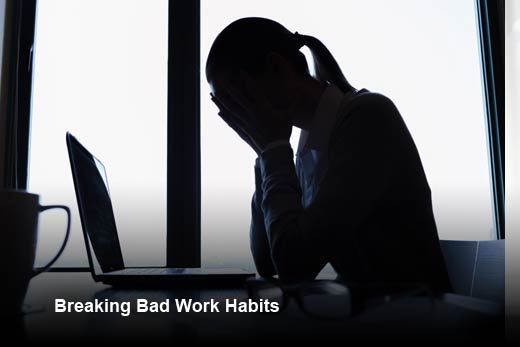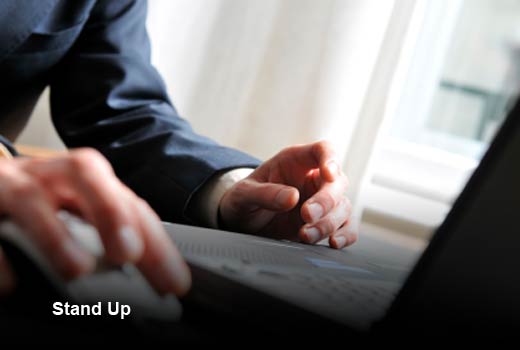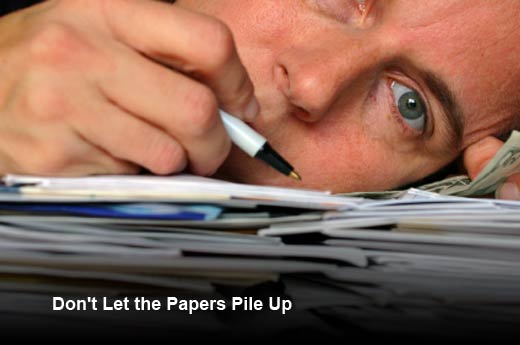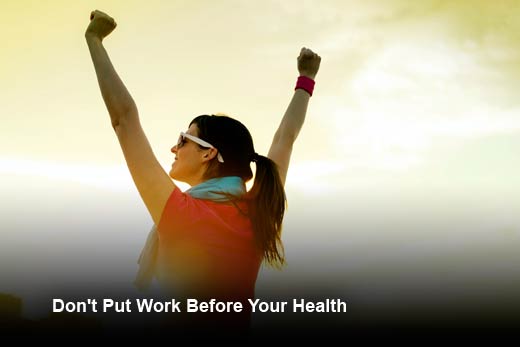As technology has evolved and more and more work is completed using computers, many workers have found themselves in sedentary office jobs. Leigh Stringer, author of “The Healthy Workplace,” says it’s not that we aren’t working hard, but that “what our minds and bodies need at a basic level is in conflict with our work style. We are so focused on work, on getting things done, that we’ve changed the way we eat, move and sleep in a way that is actually counter-productive.”
According to Stringer, taking care of worker health and wellbeing is one of the most effective ways to increase employee productivity and engagement. As an example, think back to a night when you got a full night’s sleep and compare that to a night when you stayed out a bit too late with friends. How did you feel the morning after your night with friends? Probably not bright-eyed and bushy tailed, ready to take on the challenges of the day. It’s important to put your health first, as everything hinges on that baseline.
So what are some of those unhealthy habits that we need to break? In this slideshow, Ms. Stringer offers up a comprehensive list of the “don’ts,” with suggestions on what to do instead.
Breaking Bad Work Habits
Click through for 10 bad habits that should be banned from the workplace to improve worker health and productivity, as identified by Leigh Stringer, author of “The Healthy Workplace.”
Stand Up
Don’t assume that sitting is the only way to work. It’s not.
You’ve likely read the news and have heard that sitting for long periods of time is bad for your health. The issue isn’t that we sit, the issue is that many of us sit and work without standing or walking for many hours at a time. Walking on a treadmill desk for eight hours a day is not the answer either (at least for most of us).
Instead:
- Stand up every 30 minutes and walk around every hour and a half, even if it’s just for a few minutes.
- Find surfaces around your workplace that are bar-height and stand and work for a few minutes each day.
- Take phone calls, watch presentations, read or perform other activities while standing up or even walking if it makes sense for the task at hand.
Why?
This will not only improve cardio metabolic health but it will also prevent conditions like deep vein thrombosis. According to a recent study, reactive thinking improves during walking and creativity levels are consistently and significantly higher for those walking compared to those sitting. Walking has also been shown to help with improved attention and short-term recall.
Take the Stairs
Don’t take the elevator if you can help it.
Elevators in modern buildings are typically placed front and center, which makes them good for “universal design” and accessible to all types of people with different physical abilities. However, if you do not need the elevator, you are missing out on an opportunity to make a healthier choice.
Instead:
Take the stairs and ask employers to use prompts and cues that encourage stair use:
- Paint the stairwell a lighter color so that it appears brighter and less foreboding.
- Add artwork to give it a personal touch and add visual interest.
- Pipe in pleasant music. Some buildings are actually taking music out of elevators and putting it in the stairs to make the stair experience more desirable.
- If your local building code will allow, install a magnetic “hold open” gadget on the stair door (which will release in the case of a fire). Psychologically, having a staircase that is more open feels safer — which increases use.
- Want a really simple trick to nudge stair use? Studies show that just by putting up signs that explain the health benefits of taking the stairs (such as a sign in the elevator lobby that shows how many calories you can burn), stair usage increases by 54 percent!
Why?
Taking the stairs helps you to burn more calories and has you moving more (See point #1). Taking the stairs is good for cholesterol levels and for bumping into and connecting with colleagues. Save the elevator for people who really need it.
Don’t Multi-Task While Eating
Mindless eating (eating while your head is focused on something else) typically results in eating faster and consuming more calories than if you were seated at a dining table and paying attention to what you eat. Even worse than eating at your desk? Eating take-out food at your desk! Americans eat in a restaurant five times a week, according to a recent survey conducted by Living Social.
Instead:
- Bring in your own snacks and lunch.
- Eat away from your primary workspace. Keep food and drinks away from your keyboard tray… gross!
- Invite your colleagues to have lunch with you and use eating time to connect face-to-face. If you work remotely, host a “virtual lunch” via Skype.
- Work with your local food service provider or local restaurants to provide healthy options for meetings and events.
Why?
You will automatically make better choices when you are eating without multi-tasking, because you are more aware of what you are putting in your mouth. If you can find a pleasant environment to eat in with a colleague, all the better.
Focus on Healthy Foods
Don’t put unhealthy foods front and center at work.
You know how you walk into a grocery store and find yourself buying junk food at the end of the aisle? Or have you noticed how candy is located at child-eye level by the checkout counter? Foods that are easy to spot and are presented well are not put there by accident — food companies pay for the privilege. The secret is “choice architecture,” a term for different ways in which choices can be presented to consumers, and the impact of that presentation on consumer decision making. Don’t fall victim to this at work!
Instead:
- “Hide” unhealthy foods in the kitchenette or break room by putting them in opaque or translucent containers (versus healthy food like fruit or nuts in glass containers). Companies that provide subsidized snacks are starting to opt for refrigerators with glass doors to encourage employees to grab healthy foods with a shorter shelf life (boiled eggs, salad, fruit) versus processed foods that can be left on the counter.
- Several organizations have written contracts with vendors that explicitly call for them to provision, place, package and label food in a way to encourage healthy choices. One large company Ms. Stringer interviewed has an online catering service that provides healthy choices for meetings including a “celebration guide” that offers smaller portions of sweets for employees to use when celebrating employee birthdays, work anniversaries or retirements.
Why?
You will feel better, and your co-workers will too. Healthful foods cut down on extra calories with no nutritional value, which helps productivity and the bottom line.
Don’t Let the Papers Pile Up
Paper on your desk, especially if it has been sitting there a while, is likely full of dust and dust mites, which for many people can trigger serious allergies and asthma. Do you really need all that paper in your workspace? Interestingly, Xerox conducted a study a few years ago looking at how often we use the paper by our desk. They estimated that as many as two out of every five pages printed in the office are for what it calls “daily” use, such as e-mails, Web pages, and reference materials that have been printed for a single viewing. Now a few years later, the amount of paper we need to keep lying around is likely much less.
Instead:
- File paperwork and put in place a system for removing paper or moving off-site paper that you don’t need to access on a regular basis.
- Put in place a good system for scanning and digital filing of documents, so that you and your team know where to find things later. A trusted electronic system can help reduce the need for a paper backup.
Why:
No dust mites and a cleaner desk can improve air quality. Also, removing paper can give the appearance of having more space. Big piles of paper (and all the furniture that stores it) eat into the workspace and make the workspace feel more crowded. This feeling of being “crowded in” increases stress and decreases our satisfaction with our work area.
Don’t Email After Hours
All this late night chatter increases stress, decreases sleep, and affects long-term productivity. If you are a client or a boss of someone, you are affecting the stress and sleep of everyone on your cc list when you send them emails at night. A survey put out by Good Technology found that some 80 percent of the 1,000 Americans polled said they spend seven extra hours a week or 30 extra hours a month checking emails and answering phone calls after hours.
Instead:
- Wait until normal business hours to send emails or, if you must write something, don’t press “send” until the morning. Monday morning if you’re working on the weekend, please.
- Consider using project management or communication tools with your team that allow participants to choose when they want to work on something, and take them out of a situation where information is pushed to them and they’re in reaction mode all the time.
Why?
Good email behavior results in more productivity and better sleep! One New York real estate executive Ms. Stringer spoke with has banned internal emails and is using new tools like Slack and Asana with his team. Before this ban, he was spending 100 percent of his time in the office just responding to emails – with no time for collaborating, thinking or working on the next project. Using new tools has allowed his team to work on projects in a more streamlined fashion, without a lot of back-and-forth, saving stress and time. He claims to have recaptured at least five hours a week and saved “a day” of his team’s time a week due to more efficient communication and streamlined meetings.
Don’t Skimp on Vacation Time
A survey for the career website Glassdoor found that U.S. employees use only 51 percent of their eligible paid vacation time and paid time off, according to a recent survey of 2,300 workers who receive paid vacation. Even more frightening, 61 percent of Americans work while they are on vacation, despite complaints from family members, and one in four report being contacted by a colleague about a work-related matter while taking time off, while one-in-five have been contacted by their boss.
Instead:
Plan your vacations, take them, and enjoy yourself. Give yourself and your teammates permission to unplug.
Why?
You need to refresh and revitalize to be more effective. And, your family will love you for it. According to John De Graaf, who made a documentary about overworked Americans called “Running Out of Time,” there is a high cost to not taking vacation. “Women who don’t take regular vacations are anywhere from two to eight times more likely to suffer from depression, and have a 50 percent higher chance of heart disease,” he says. “For men, the risk of death from a heart attack goes up a third.”
Don’t Go to Work When You Are Sick
When you come into the workplace sick, you are very likely spreading diseases to colleagues, which reduces organizational productivity. As tempting as it is for you to “power through” and minimize sick days, the overall health risk is not worth it.
Instead:
Stay home!
Why?
Researchers from the University of Arizona in Tucson placed a tracer virus on commonly touched objects such as doorknobs or tabletops in workplaces. At multiple time intervals, the researchers sampled a range of surfaces including light switches, countertops, sink tap handles, and pushbuttons. They found that between 40 and 60 percent of the surfaces were contaminated within two to four hours. This may be a reason to adopt a “work from home” policy, if you are looking for one. Beyond that, everyone should frequently wash their hands.
Don’t Stay Indoors All Day
A good portion of our global workforce spends 90 percent of each day indoors, which essentially puts workers in a state of “light deficiency,” and it negatively impacts our sleep cycle.
Instead:
Get outside, preferably earlier in the day, and for as long as you can.
Why?
We need more intense light to reset our circadian rhythm, which helps us sleep. Some sleep experts recommend being outside as much as two hours a day, but even going outside for 30 to 60 minutes during the day – say over a lunch break or during a walking meeting outdoors, will provide roughly 80 percent of what you need to “anchor” your circadian rhythm, according to Dan Pardi, a researcher with the Psychiatry and Behavioral Sciences Department at Stanford, and the Departments of Neurology and Endocrinology at Leiden University in the Netherlands.
Don’t Put Work Before Your Health
If you aren’t healthy, you can’t get anything done and you won’t be there for your colleagues, friends and family when they need you — especially if you are affected by chronic health issues. A global survey of business executives conducted by the World Economic Forum and the Harvard School of Public Health from 2009 to 2011 identified non-communicable diseases as one of the leading threats to global economic growth.
Instead:
Make your health a priority, and start by building time in your calendar to work out, to relax or do something that gives you energy and sparks your personal passion.
Why?
Healthy workers are more productive. The most obvious benefits to the bottom line are the avoidance of health care costs, but companies that make investments in employee health and wellbeing are also seeing increases in creativity, engagement, productivity and, as a result, business growth. Being our emotional, physical and mental best is foundational to doing our best work. It’s time to get our priorities straight, and make worker health and wellbeing a foundation for good business, not just a “nice to have.”













